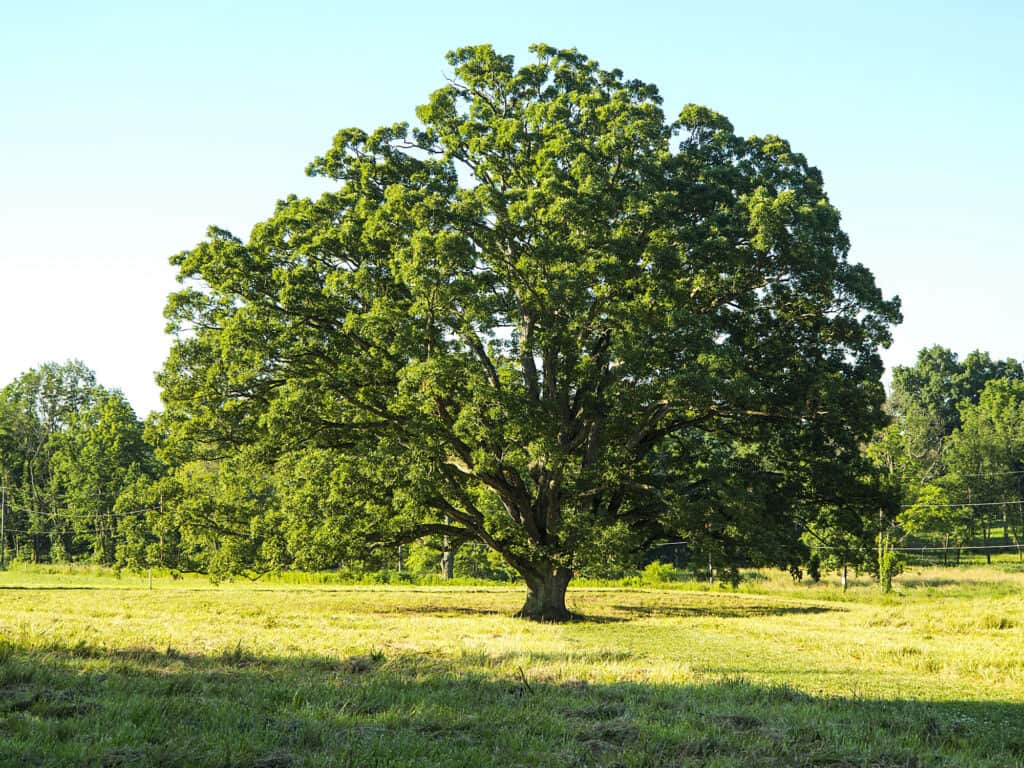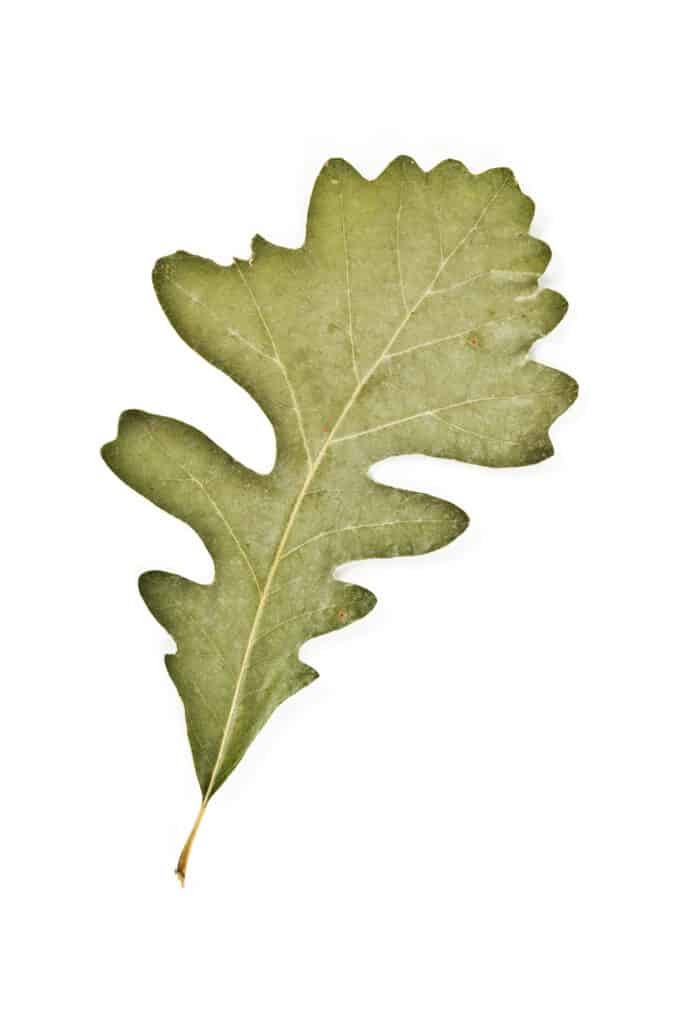Bur oak and white oak are two very handsome trees that are similar in appearance and help feed a variety of wild animals. Both are native to North America, but can you spot the differences between the two? Let’s take a closer look at bur oaks and white oaks.
The Key Differences Between Bur Oaks and White Oak
These two oaks are similar and often confused, but knowing the two main differences between them can help you easily tell them apart.
In the fall of the year, you’ll notice that their acorns are vastly different. Instantly recognizable bur acorns are large and almost entirely covered in a fuzzy cap. The acorns of white oaks have smaller, non-fuzzy caps. Other times of the year you can tell bur oaks from white oaks by their bark. White oaks have pale smooth bark, whereas bur oaks’ is dark gray with deep fissures.
| Bur Oak vs. White Oak: | Bur Oak | White Oak |
|---|---|---|
| Name | Bur oak (Quercus Macrocarp) | White oak (Quercus Alba) |
| Other names | Burr oak, mossycup oak, mossycup white oak, blue oak, or scrub oak. | stave oak |
| Native range | Eastern and Mid-Western North America, Southern Canada | Eastern North America |
| Height and Spread | Up to 100 feet by 100 feet | Up to 100 feet by 100 feet |
| Acorns | Large 1.5 inches long with a fuzzy woolly cap covering most of the acorn. Green and matures to brown | Up to one inch long, green maturing to brown |
| Bark | Dark gray with deep fissures | Pale gray, smooth |
| Foliage | Lobed green foliage, random number of lobes, curbed vein. May turn yellow in fall | 5-7 regular lobes with straight veins, emerge pink or silver, mature to green, then red and orange in fall |
| Toxicity | All parts toxic to dogs and horses | All parts toxic to dogs and horses |
History of Bur Oak and White Oak Trees
America is home to dozens of oak trees that grow wild or are cultivated in gardens, parks, and along streets. They are part of the Quercus genus in the Fagaceae family of beeches.
The name Quercus is Latin for oak tree and in North America the oaks are usually classified in two categories which are red oaks and white oaks. The difference is that white oaks develop their acorns in one year but red oaks take two years to mature.
Both bur oak and white oak are classified as white oaks. It’s easy to get confused by the white oak names, but just remember that the white oak Quercus Alba is an individual tree that’s classified as the white oak in the category of white oaks!
Bur Oaks (Quercus Macrocarpa)

Bur oaks are the largest American oak acorns. Each acorn can measure 1.5 inches in length and one inch in diameter!
©iStock.com/EIBrubaker
Bur oaks are deciduous and generally grow in lowland environments, but they can be found in mountainous areas, as they are adaptable to different soils. The largest bur oaks are fire-tolerant, which may be an evolved feature because they’re a common sight in oak savannas which are prone to forest fires.
There are several parks and cities named for bur oaks, including Burr Oak, Kansas, Burr Oak, Iowa, and Burr Oak, Michigan. There’s also Burr Oak State Park in Ohio.
Its name in English and Latin refers to its acorns which are covered in burr-like fuzz and very large. Macrophyla is Latin for large-fruited.
There are two recognized varieties:
- Quercus macrocarpa var. macrocarpa
- Quercus macrocarpa var. depressa (Nutt.) Engelm.
White Oak (Quercus Alba)

White oaks get their name from the dried, worked wood, not from the color of the tree.
©iStock.com/Cris Andrei
White oaks are deciduous lowland trees with pale bark. The word Alba is Latin for white which refers to it’s worked wood that dries out to be much paler than its living trunk.
There are several white oaks in America that are known for their exceptionally long lives. One is The Great White Oak in Basking Ridge, New Jersey, which was estimated to be 600 years old! It reached a height of 75 feet and had a trunk with a 25 foot circumference! Unfortunately, it had to be cut down in 2017 due to poor health.
An image of the Charter Oak (a white oak) is on Connecticut’s state quarter because in 1687 it’s its hollow trunk was used to hide the Connecticut Charter from the British. It’s also Connecticut’s state tree, as well as the state tree of Illinois and Maryland.
White Oak Native Origins
White oak trees are widespread and native to Eastern North America where they grow in valleys, ridges, and mountains.
Bur oak is native to America. It has a wide range from the Eastern to the Midwestern States and South-Central Canada. It grows in open spaces, especially prairies.
How Tall Do Bur Oak and White Oak Grow?
Both of these handsome oaks are tall and have large spreading canopies, that can reach 80 – 100 feet when they’re mature, though white oak is slower growing.
Their canopies can stretch as wide as their height, but the structure is different. White oak has a vase-shaped crown with upward-angled branches whereas bur oak is a little more haphazard. Its upper branches grow at random angles including upward, right angles, and even pointing dow.
Both varieties will grow to be quite large, so it’s a good idea to think carefully about where you plant them.
Bur Oak vs. White Oak: Bark
The easiest all-season way to identify a white oak from a bur oak is their bark.
Bur oaks have dark-gray bark that’s rough, deeply fissured, and cracked in vertical lines. The tough ridges create homes for insects. In contrast white oaks have light-gray bark that’s smoother than bur oak. White oak bark appears thinner and flakes in smaller pieces than the bur oak, which has large deep furrows.
Bur Oak and White Oak Foliage Differences

Bur oak leaves can have differing numbers of lobes from leaf to leaf, from two all the way to 15!
©iStock.com/ByMPhotos
Although they are similar and very definitely traditionally-lobed oak leaves, bur and white oak have differing foliage.
White oak leaves reach up to eight inches long by four inches wide on mature trees. They have seven to nine lobes with a straight central vein and straight side veins.
Its foliage emerges pale pink with a fluffy protective blanket. From a distance, newly sprouting white oaks look frosty. As leaves mature they turn yellow, then glossy green at the height of summer, and finally rich red and purple during fall.
White oak is the sole food source for Bucculatrix luteella and Bucculatrix ochrisuffusa moth caterpillars.
The bur oak’s leaves are smaller, only reaching up to six inches long by five inches wide. They’re lobed too, but each leaf can have any number of lobes from just two up to 15. Like its haphazard branches, the foliage is irregular with mismatched lobes and veins that curve.
Foliage emerges pale green in spring, turns mid-green by summer, and in fall it may turn golden-brown, unlike white oak, it does not sport spectacular colors.
Bur oak foliage is the sole food for a moth caterpillar called Bucculatrix recognita.
Do Oak Trees Have Flowers?
Yes, oak trees have flowers that turn into acorns.
Oak flowers are commonly called catkins, and they bloom in mid-spring. They are staminate, hairy, and hang down in strings up to three inches long. Male and female flowers bloom on one tree, and the male flowers have anthers that hold the pollen.
Bur oaks have long green catkin strings in groups of up to ten that bloom on the previous year’s new branches.
White oaks have the same long catkin strings, but they are yellow-green and slightly brighter than Bur oak flowers.
Do Oaks Have Nuts?
Yes, if their catkin flowers are pollinated, oak trees develop nuts called acorns. White oak and bur oak have very different acorns and it’s the easiest way to tell them apart.
Bur oaks have the largest American oak acorns which can measure 1.5 inches in length by one inch in diameter. This gives rise to their botanical name macrophylla, which we know means large-fruited, but it’s actually the cap that creates most of its size.
The cap covers more than half of the acorn and frequently covers it entirely. It has a scaly margin and long frilly tips that peel backward to give it a burred appearance. Inside, the acorn is mid-green maturing to deep brown as it ripens.
White oak acorns are smaller, not quite one inch by one-half inch wide. Their cap is not elongated, so most of the acorn is visible. These acorns start out bright-green, maturing to deep, rich brown during fall.
Acorns are an important food source of wildlife (Scrat from Ice Age was right to hold onto his acorn!). Black bears, birds, rabbits, squirrels, and deer all eat them. Deer, porcupines, and cattle will also eat oak tree foliage and young bark.
What Is Masting?
Attempting to protect their babies, oak trees evolved an incredible strategy called masting.
When an oak “masts” it produces a huge crop of acorns, but it will only do this every two to three years. The enormous harvest is more than the predators can eat. This helps to ensure young saplings survive. Clever trees!
Are Oak Trees Toxic?
The ASPCA says fresh and fallen oak leaves, bark, and acorns are toxic for pets including horses because they contain a chemical called gallotannin. Acorns also pose a choking threat to pets and children.
Up Next
The photo featured at the top of this post is © Artorn Thongtukit/Shutterstock.com
Sources
- bplant.org, Available here: https://bplant.org/compare/173-185
- bplant.org, Available here: https://bplant.org/compare/173-185
- ASCPA, Available here: https://www.aspca.org/pet-care/animal-poison-control/toxic-and-non-toxic-plants/oak
- Kyle A. Funk, Walter D. Koenig, and Johannes M.H. Knops, Available here: https://cdnsciencepub.com/doi/abs/10.1139/cjfr-2015-0227
- David W. Peterson,Peter B. Reich, Available here: https://esajournals.onlinelibrary.wiley.com/doi/abs/10.1890/1051-0761(2001)011%5b0914:PFIOSF%5d2.0.CO;2
Thank you for reading! Have some feedback for us? Contact the AZ Animals editorial team.






